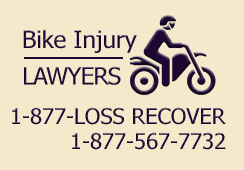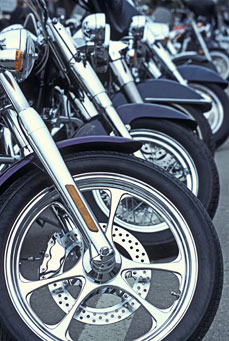Bike Injury Lawyers
Tuesday, April 27, 2010
This blog has moved
This blog is now located at http://thebikeinjurylawyers.blogspot.com/.
You will be automatically redirected in 30 seconds, or you may click here.
For feed subscribers, please update your feed subscriptions to
http://thebikeinjurylawyers.blogspot.com/feeds/posts/default.
posted by
edanjou
at
10:11 AM
0
comments
![]()
Thursday, April 8, 2010
Bicycle Accident Facts
The loss of 698 lives in bicycle/motor vehicle crashes in 2007, just under two people every day, is a shocking statistic. While lower than the 814 fatalities in 1997, bicycling accidents were on the rise just a few years ago. These numbers represent 2% of the total number of people killed and injured in traffic crashes in 2007.
The number of reported injuries involving bicyclists has followed a similar trend, from 68,000 in 1993 to 41,000 in 2003, only to rise again in 2005. Fortunately, the 43,000 reported injuries in 2007 represent another decline. However, we know from research into hospital records that only a fraction of bicycle crashes causing injury are ever recorded by the police, possibly as low as ten percent. Because cyclists have very little protecting them from the unrelenting hard surfaces of the road and cars, bike accidents usually result in very serious injuries or death.
Some quick bike accident statistics:
- Bicycle deaths in US in 1997: 814
- Bicycle deaths in US in 2007: 698
- Reduction in bike deaths in that ten year period: 14%
- Bike injuries in US in 1997: 58,000
- Bike injuries in US in 2007: 43,000
- Reduction in bike injuries in that ten year period: 26%
- Total cost of bicyclist injury and death in US each year: $5.4 billion
If you or a loved one has been injured or killed in a bicycle accident, you may have a valid legal personal injury claim and should contact an experienced bicycle accident attorney in your area today.
posted by
Erica
at
8:35 AM
0
comments
![]()
Monday, March 8, 2010
Educate Cyclists and Motorists
Education can be a powerful tool for changing behavior and improving safety skills. Bicyclists and motorists alike can benefit from educational tools and messages that teach them the rules, rights, and responsibilities of various modes of travel.
There are major differences in the bicycling abilities, behavioral patterns, and learning capacities of different groups of bicyclists and other road users. For example, children have different physical and psychological abilities than adult bicyclists, young drivers exhibit different behaviors and driving skills than older drivers, and college age bicyclists may be reached through educational outlets that differ from those of other groups. Because of this, educational programs need to be tailored to the specific audiences they intend to address and to the behaviors they seek to modify.
Enforcing traffic laws and regulating bicyclists, motorists, and other roadway users is a key element for ensuring a safe and healthy bicycling environment. Enforcement programs can be used to educate roadway users about the traffic laws that govern them; serve as periodic reminders to obey traffic rules; encourage safer behaviors; and monitor and protect public spaces. They can also help reinforce and support educational programs and messages.
For many communities, the first step for building an enforcement program lies in reviewing and modifying laws and policies affecting bicyclists. It is critical that effective procedures are in place for handling violators and for training law enforcement officers.
If you or a loved one has been injured or killed in a bicycle accident, you may have a valid legal personal injury claim and should contact an experienced bicycle accident attorney in your area today.
posted by
Erica
at
8:35 AM
0
comments
![]()
Monday, February 8, 2010
Ride Your Bike as if You Were Invisible
Riding a bike is something that many of us enjoy in the spring, summer and autumn months, but that enjoyment can quickly turn to horror if we are involved in a bike accident. Very little, if anything, protects a cyclist from the hard surface of the road or a passenger vehicle. For this reason, bike accidents often result in catastrophic injuries and death.
It is helpful to ride your bike in such a way that motorists will not hit you even if they do not see you. On very fast roads, cars have less time to see you because they're approaching so fast. Of course, you should avoid fast roads in the first place, if at all possible, unless there's plenty of room for a car and a bike side by side. And if there is such room, then on fast roadways you can practice invisibility by riding to the extreme right. If you're far enough right that you're not in the part of the lane the cars are in, then they'll drive by and won't hit you, even if they never saw you.
When riding a bike as if you were invisible, you are simply riding with the assumption that cars cannot see you. Of course, you want to be seen by motorists and you should help them see you.
If you or a loved one has been injured or killed in a bicycle accident, you may have a valid legal personal injury claim and should contact an experienced bicycle accident attorney in your area today.
posted by
Erica
at
8:34 AM
0
comments
![]()
Friday, January 8, 2010
How to Avoid the “Right Hook” Collision
While riding a bicycle on a warm spring day can be an exhilarating and fun experience, there are many more dangers in riding a bicycle than in riding in a passenger vehicle, for the obvious reason that cyclists have nothing protecting them from the hard surfaces of the road and cars. Bike accidents, for this very reason, often result in serious injuries and death because the riders are so vulnerable to the environment surrounding them.
The "right hook" collision occurs when a passenger vehicle passes a bike and then tries to make a right turn directly in front of the bike, or it turns right into you. There are steps to take to avoid this collision.
Drivers in passenger vehicles may not think you're going very fast on your bike, and they may think they have plenty of time to pass you. The right hook collision is very difficult to avoid because the cyclist is not seen until the very last second, often when it's too late.
To avoid a right hook collision, a cyclist should:
- Avoid riding on the sidewalk. When you come off the sidewalk to cross the street, you are invisible to motorists.
- Ride to the left. Taking up the whole lane makes it harder for drivers to pass you to cut you off or turn into you. If the lane you are riding in is not wide enough for cars to pass you safely, then you should take up the whole lane.
- Look in your mirror before approaching an intersection. Be sure to look in your mirror well in advance of arriving at the intersection. As you go through the intersection, you must pay careful attention to what is in front of you
If you or a loved one has been injured or killed in a bicycle accident, you may have a valid legal personal injury claim and should contact an experienced bicycle accident attorney in your area today.
posted by
Erica
at
8:32 AM
0
comments
![]()
Friday, March 20, 2009
How to Avoid a Collision When on a Bike
There are ways, however, to minimize your chances of being in a collision with a passenger vehicle:
Get a headlight for your bike. If you ride at night, you must absolutely use a headlight so other vehicles can see you. In many states, bicyclists are required, by law, to install a headlight on their bike. Even for daytime riding, a bright light that has a flashing mode can make you much more visible to other motorists and reduce your chances of being hit.
Get a horn. A cyclist can use a horn just as a motorist would. If you don’t have a horn then you can yell to get a motorist’s attention. While you may be embarrassed yelling or honking a horn, it’s better to be embarrassed than to get hit.
Ride further left. If you are riding all the way to the right, and a motorist pulls out, your only option may be to run right into the driver’s door. Riding more to the left can reduce your chances of being hit by a passenger vehicle.
If you or a loved one has been injured or killed in a bicycle accident, you may have a valid legal personal injury claim and should contact an experienced bicycle accident attorney in your area today.
posted by
Lynn
at
6:32 AM
0
comments
![]()
Friday, February 27, 2009
Bike Accident Overview
An automobile driver turning directly in front of a bicyclist
An automobile driver entering the street from a driveway or parking spot and pulls out into traffic in front of the bicyclist
A motorist's failure to yield at an intersection or running a stop sign or red light
A vehicle driver's inattention while driving past a bicyclist
An automobile driver's failure to look both ways when resuming travel after stopping at a stop sign
An automobile driver is under the influence of drugs or alcohol
Bicycle accident attorneys can do the following for their bike accident clients:
Investigate and, where appropriate, closely analyze any damage that occurred to the bicycle, such as chipped paint, stressed metal, bent wheels and torn brake pads
Examine the remains of a bike wreck and seek to counter a motorist’s typical claims that a cyclist was speeding or squeezed the brake levers too hard or swerved into traffic.
Due to the increase in bike traffic throughout the United States, many cities have constructed special bike lanes. Parks now have trails that are accessible to bicycles, and some vehicle manufacturers are even offering bike racks as standard equipment. However, many automobile drivers do not respect the bicyclists' rights to share the roads and, more importantly, many cyclists have not been properly educated on how to legally and safely share the roads with automobiles.
If you or a loved one has been injured or killed in a bicycle accident, please contact an experienced bike accident attorney in your area today.
posted by
Lynn
at
8:27 AM
0
comments
![]()





